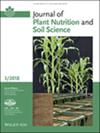Genotypic Variability in Root System Architecture and Its Association With Fe and Zn Biofortification in Wheat (Triticum aestivum L.)
Abstract
Background
Wheat has an inherently low concentration of Fe and Zn; therefore, enhancing their concentrations in grains has become vital to mitigate micronutrient malnutrition in many developing countries through biofortification strategies.
Aims
This study aims to explore variability in root architectural traits and their roles in Fe and Zn uptake leading to its accumulation in grains.
Methods
A rhizobox-based experiment was conducted to evaluate the effect of Fe- and Zn-deficient and -sufficient conditions on wheat root system architecture (RSA). Four treatments of Fe and Zn fertilizer combinations with four replications were used in these experiments (without Fe and Zn, with Zn and without Fe, without Zn and with Fe, and with Fe and Zn). Further, in a pot experiment, physiological attributes, growth, yield, and uptake of Fe and Zn were determined in the selected eight wheat varieties based on rhizobox trial results.
Results
Significant genotypic variability was noted in RSA traits of wheat genotypes, and some interesting correlations have been identified. Zinc-efficient varieties Zincol-16 and Akbar-19 revealed better RSA traits like enhanced root diameter, lateral root density, and root length as compared to inefficient varieties like Ujala-16 and TD-1. The Zincol-16 articulated maximum improvement in grain Fe and Zn content, that is, 53.9 mg Fe kg−1 concentration in the treatment with soil Fe application and 33.18 mg Zn kg−1 found in treatment with soil application of Zn. Yield attributes were significantly improved by the combined application of Fe and Zn, as the pot experiment showed that maximum thousand-grain weight (47.3 g) and grain yield (12.4 g per pot) were found in Akbar-19.
Conclusion
This study suggests that genetic variability in RSA correlates with increased Fe and Zn concentrations in grains. Therefore, by using RSA attributes for Fe and Zn biofortification in wheat, these findings may be used in breeding programs to develop new biofortified varieties to mitigate micronutrient malnutrition.

 求助内容:
求助内容: 应助结果提醒方式:
应助结果提醒方式:


